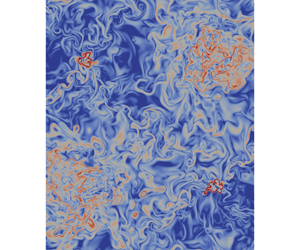Published online by Cambridge University Press: 20 November 2019

We analyse the entrainment and energetics of equal and opposite axisymmetric turbulent air plumes in a vertically confined space at a Rayleigh number of  $1.24\times 10^{7}$ using theory and direct numerical simulation. On domains of sufficiently large aspect ratio, the steady state consists of turbulent plumes penetrating an interface between two layers of approximately uniform buoyancy. As described by Baines & Turner (J. Fluid Mech., vol. 37(1), 1969, pp. 51–80), upon penetrating the interface the flow in each plume becomes forced and behaves like a constant-momentum jet, due to a reduction in its mean buoyancy relative to the local environment. To observe the behaviour of the plumes we partition the domain into sub-domains corresponding to each plume. Domains of relatively small aspect ratio produce a single primary mean-flow circulation between the sub-domains that is maintained by entrainment into the plumes. At larger aspect ratios the mean flow between the sub-domains bifurcates, indicating the existence of a secondary circulation within each layer associated with entrainment into the jets. The largest aspect ratios studied here exhibit an additional, tertiary, circulation in the vicinity of the interface. Consistency between independent calculations of an effective entrainment coefficient allows us to identify aspect ratios for which the flow can be modelled using plume theory, under the assumption of a two-layer stratification. To study the flow’s energetics we use a local definition of available potential energy (APE). For plumes with Gaussian velocity and buoyancy profiles, the theory we develop suggests that the kinetic energy dissipation is split equally between the jets and the plumes and, collectively, accounts for almost half of the input of APE at the boundaries. In contrast, 1/4 of the APE dissipation and background potential energy (BPE) production occurs in the jets, with the remaining 3/4 occurring in the plumes. These bulk theoretical predictions agree with observations of BPE production from simulations to within 1 % and form the basis of a similarity solution that models the vertical dependence of APE dissipation and BPE production. Unlike results concerning the dissipation of buoyancy variance and the strength of the circulations described above, the model for the flow’s energetics does not involve an entrainment coefficient.
$1.24\times 10^{7}$ using theory and direct numerical simulation. On domains of sufficiently large aspect ratio, the steady state consists of turbulent plumes penetrating an interface between two layers of approximately uniform buoyancy. As described by Baines & Turner (J. Fluid Mech., vol. 37(1), 1969, pp. 51–80), upon penetrating the interface the flow in each plume becomes forced and behaves like a constant-momentum jet, due to a reduction in its mean buoyancy relative to the local environment. To observe the behaviour of the plumes we partition the domain into sub-domains corresponding to each plume. Domains of relatively small aspect ratio produce a single primary mean-flow circulation between the sub-domains that is maintained by entrainment into the plumes. At larger aspect ratios the mean flow between the sub-domains bifurcates, indicating the existence of a secondary circulation within each layer associated with entrainment into the jets. The largest aspect ratios studied here exhibit an additional, tertiary, circulation in the vicinity of the interface. Consistency between independent calculations of an effective entrainment coefficient allows us to identify aspect ratios for which the flow can be modelled using plume theory, under the assumption of a two-layer stratification. To study the flow’s energetics we use a local definition of available potential energy (APE). For plumes with Gaussian velocity and buoyancy profiles, the theory we develop suggests that the kinetic energy dissipation is split equally between the jets and the plumes and, collectively, accounts for almost half of the input of APE at the boundaries. In contrast, 1/4 of the APE dissipation and background potential energy (BPE) production occurs in the jets, with the remaining 3/4 occurring in the plumes. These bulk theoretical predictions agree with observations of BPE production from simulations to within 1 % and form the basis of a similarity solution that models the vertical dependence of APE dissipation and BPE production. Unlike results concerning the dissipation of buoyancy variance and the strength of the circulations described above, the model for the flow’s energetics does not involve an entrainment coefficient.